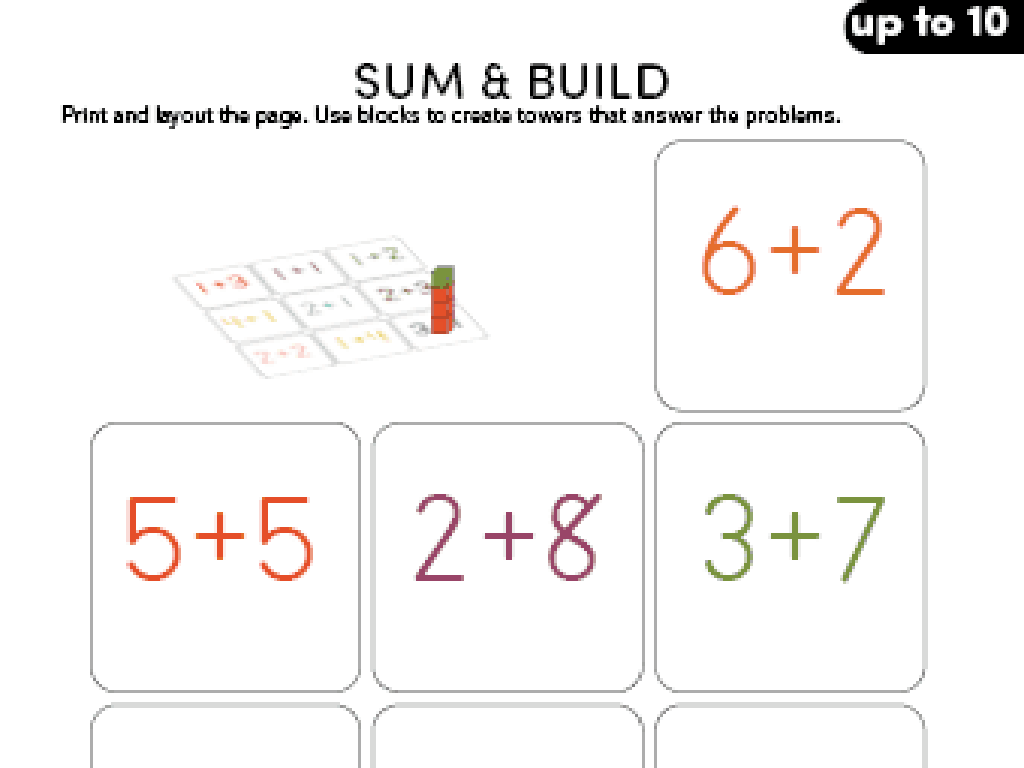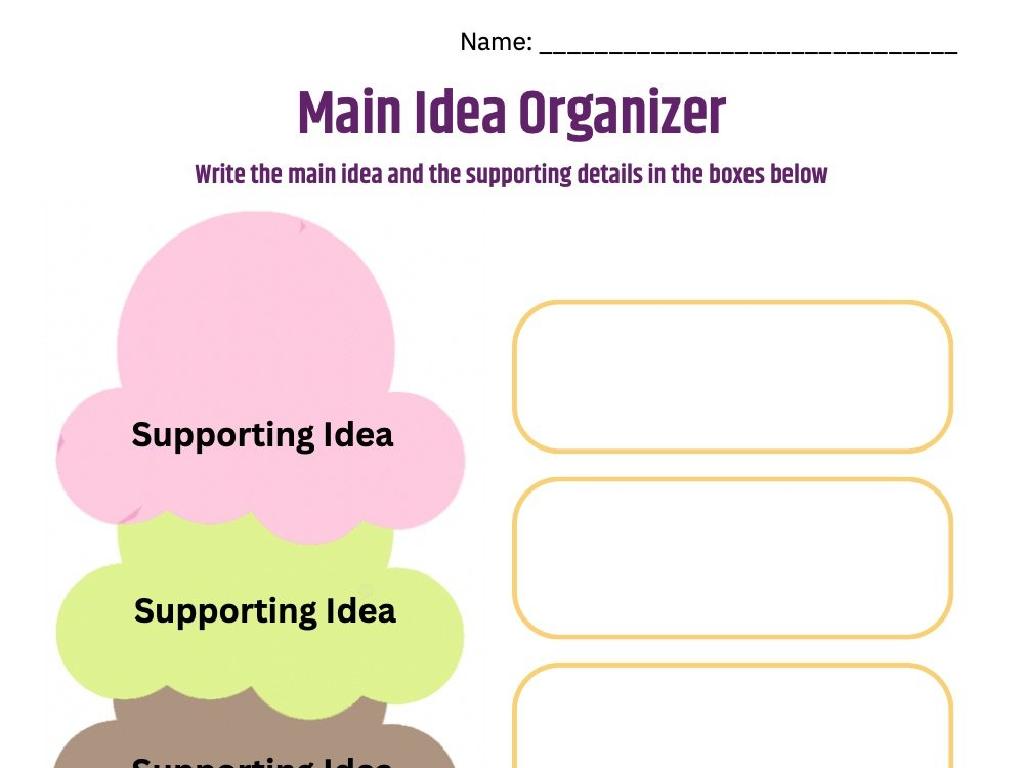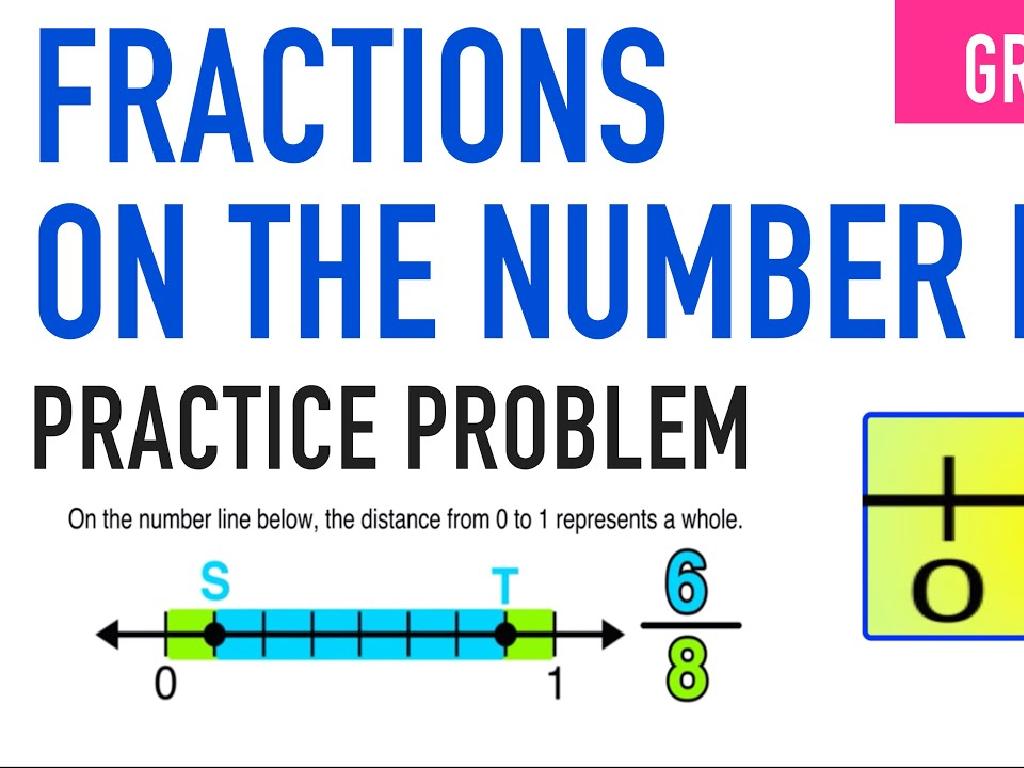Find The Area Between Two Rectangles
Subject: Math
Grade: Third grade
Topic: Area
Please LOG IN to download the presentation. Access is available to registered users only.
View More Content
Area Exploration: Between Two Rectangles
– What is area?
– Area is the space inside a shape’s boundary
– Area of rectangles
– Multiply length by width for rectangle’s area
– Finding area between two rectangles
– Subtract smaller rectangle’s area from larger one
– Why learning area is important
|
Begin the lesson by explaining the concept of area as the amount of space inside the boundary of a shape. Use simple language and examples to illustrate the idea. Then, move on to calculating the area of rectangles by multiplying the length by the width. For finding the area between two rectangles, demonstrate how to subtract the area of the smaller rectangle from the area of the larger one. Emphasize the practical applications of understanding area in real life, such as determining the amount of paint needed for a wall or the size of a garden. Encourage students to think of other examples where knowing how to calculate area might be useful.
Exploring Area: Space Inside Rectangles
– Area is space measured in squares
– Like tiles on a floor, we count how many squares fit inside
– To find area: multiply length by width
– If a rectangle is 3 units long and 2 units wide, area is 3 x 2 = 6 square units
– Let’s calculate a rectangle’s area
– We’ll use a fun example together as a class
– Practice finding area with examples
– Try with different sizes and see how the area changes
|
This slide introduces the concept of area to third-grade students, explaining it as the amount of space inside a shape, measured in square units. Start by visualizing the concept with objects they are familiar with, like tiles on a floor or blocks in a game. Demonstrate how to calculate the area of a rectangle by multiplying the length and width. Engage the class with an interactive example, calculating the area of a rectangle together. Then, encourage students to practice with different sizes of rectangles, either on paper or with physical objects, to reinforce the concept. The goal is for students to understand area as a practical and visual concept, not just an abstract mathematical formula.
Discovering Rectangles Around Us
– Spot rectangles in the classroom
– Rectangles are all around us
– Look at doors, books, and windows
– List rectangle-shaped items
– Work together to find everyday objects
– Group activity time
|
This slide is meant to engage students in a group activity where they will identify rectangle-shaped objects within the classroom. Encourage the students to look around and spot as many rectangles as they can, such as windows, doors, books, and desks. This activity helps them recognize the presence of geometric shapes in their everyday environment. Divide the class into small groups and have each group list the rectangle-shaped items they find. This will foster teamwork and observational skills. After the activity, discuss why rectangles are so common and how recognizing them helps us understand the concept of area better. Provide guidance on how to measure the length and width of these items to calculate the area in subsequent lessons.
Comparing Two Rectangles
– How to compare rectangle sizes
– Using area formula
– Area = length x width
– Calculate area of rectangle A
– Find length and width of A, then multiply
– Calculate area of rectangle B
– Find length and width of B, then multiply
|
This slide is aimed at teaching students how to compare the sizes of two rectangles by calculating their areas. Start by explaining that the area of a rectangle tells us how much space it covers. Introduce the formula for finding the area of a rectangle (Area = length x width). During practice time, guide students to find the length and width of each rectangle and use the formula to calculate the area. Encourage them to write down their calculations and compare the results to determine which rectangle is bigger. For the activity, provide different pairs of rectangles so each student can practice this skill. Offer assistance as needed and ensure that students understand the concept of area before moving on to more complex shapes.
When Rectangles Overlap: Shared Areas
– Overlapping rectangles explained
– Two rectangles can cover some of the same space.
– How to find the shared area
– Subtract the smaller area from the larger to find the overlap.
– Use colors to see overlap
– Coloring helps us see the common area clearly.
– Practice with examples
|
This slide introduces the concept of overlapping rectangles and how to find the area they share, which is a key skill in understanding spatial relationships and geometry. Start by explaining that when two rectangles overlap, they share a common space. To find the size of this shared area, we can use subtraction: take the area of the larger rectangle and subtract the area of the smaller one that is outside the overlap. Using different colors to shade the areas on a grid can help students visualize and understand the concept better. Provide examples of overlapping rectangles and encourage students to practice with colored pencils or markers to identify the shared areas.
Calculating Area Between Two Rectangles
– Find area of larger rectangle
– Multiply length by width of the outer rectangle
– Find area of smaller rectangle
– Multiply length by width of the inner rectangle
– Subtract smaller from larger
– Take the larger area and minus the smaller area
– Discover the area in-between
|
This slide introduces the concept of finding the area between two rectangles, a skill that combines knowledge of area calculation and subtraction. Start by explaining how to calculate the area of a rectangle (length times width). Then, guide students through finding the area of both the larger and smaller rectangles using this method. Emphasize that the area between the two rectangles is found by subtracting the area of the smaller rectangle from the area of the larger one. Provide examples with actual measurements and encourage students to visualize the space between the rectangles as a separate area to be discovered. This concept can be related to real-life scenarios, such as finding the area of a frame around a picture or a window.
Example Time: Area Between Two Rectangles
– Work through an example together
– Use steps to find the area
– We’ll subtract the smaller area from the larger area
– Solve any questions you have
– Ask questions if you’re unsure about the steps
– Practice makes perfect!
– We’ll do more examples for better understanding
|
This slide is designed to engage students in a practical example of finding the area between two rectangles. Start by drawing two rectangles, one inside the other, on the board. Walk through the process step by step: calculate the area of the larger rectangle, then the smaller one, and subtract the smaller area from the larger to find the area in between. Encourage students to ask questions if they’re confused at any point. After explaining, give them a few similar problems to solve on their own or in small groups to reinforce the concept. This hands-on practice will help solidify their understanding of the topic.
Class Activity: Area Detectives
– Become an Area Detective!
– Mission: Find the missing area
– The space between two rectangles on your paper
– Work in pairs for mystery solving
– Team up with a classmate and discuss strategies
– Use your worksheet rectangles
– Look at the shapes on your worksheet to start
|
In this engaging class activity, students will pair up and act as ‘Area Detectives’ to find the area between two rectangles on their worksheets. This exercise will help them apply their knowledge of calculating the area of rectangles in a fun and interactive way. Provide students with clear instructions on how to calculate the area of a single rectangle and then guide them to understand how to find the area that lies between two overlapping rectangles. Encourage them to discuss their problem-solving strategies with their partners and to check each other’s work. Possible activities could include using different colored pencils to shade the areas, using grid paper to count squares, or creating their own set of ‘mystery rectangles’ for their partner to solve.
Area Detectives: Mission Accomplished!
– Congratulations, Area Detectives!
– Review: Finding area between rectangles
– Remember to subtract the smaller area from the larger area
– Receive your Area Detective badges
– Keep exploring areas in real life
– Look for shapes around you and think about their area
|
This slide is meant to congratulate the students on completing the lesson and to serve as a recap of the key points. Emphasize the steps they’ve learned to find the area between two rectangles, which involves calculating the area of both rectangles and then subtracting the smaller area from the larger one. Hand out the Area Detective badges to celebrate their participation and hard work. Encourage them to continue observing and thinking about the area of objects they come across in their daily lives, reinforcing the concept outside of the classroom. This will help solidify their understanding and make the concept of area more tangible and relevant.






